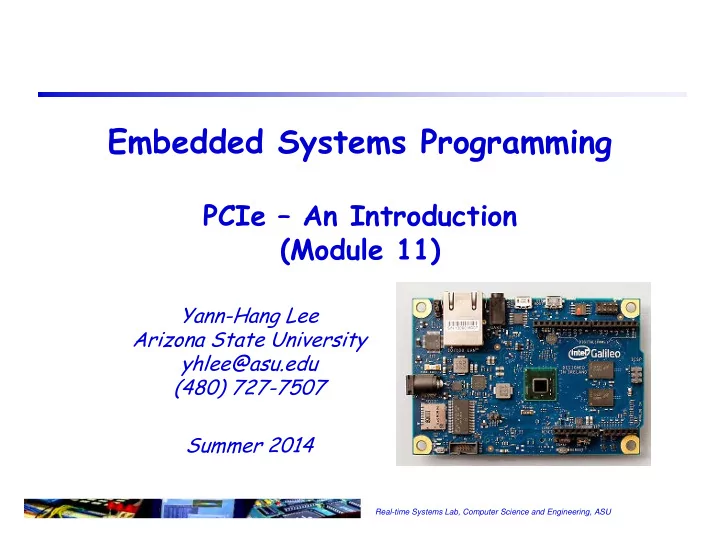

Embedded Systems Programming PCIe – An Introduction (Module 11) Yann-Hang Lee Arizona State University yhlee@asu.edu (480) 727-7507 Summer 2014 Real-time Systems Lab, Computer Science and Engineering, ASU
PCI Challenges Limited Bandwidth PCI-X and Advanced Graphics Port (AGP) for higher frequency Reduction of distance Bandwidth shared between all devices Limited host pin-count Lack of support for real time data transfer Stringent routing rules Lack of scaling with frequency and voltage Absence of power management PCI-X -- an enhancement of the 32-bit PCI Local Bus for a higher bandwidth demand. a double-wide version of PCI, running at up to four times the clock speed 1 Real-time Systems Lab, Computer Science and Engineering, ASU
Inter-Networking Driving Demand Multimedia applications drive the need for fast, efficient processing of data over wired or wireless media CPU performance doubles about every 18 months while PC Bus performance doubles about every 3 years 10000 10 Gbit Ethernet 500-1000 1000 Gbit 350-400 Relative Bandwidth Ethernet 133-200 75-100 100 Fast Ethernet 66 40-50 PCI-X 8 12 16-20 25-33 PCI 64/66 PCI 32/33 EISA 10 16b ISA MCA 8b ISA 4.77 0 1980 1985 1990 1995 2000 Source: Intel 2 Real-time Systems Lab, Computer Science and Engineering, ASU
PCI Express Basics Serial, point-to-point, Low Voltage Differential Signaling 2.5GHz full duplex lanes (2.5Gb/s) PCI Express Device 1 PCIe Gen 2 = 5Gb/s Scaleable links – x1, x4, x8, x16 Packet based transaction protocol Ref Software compatible but with higher speeds Clock Lane Built-in Quality of Service provisions Virtual Channels Traffic Classes PCI Express Reliability, Availability and Serviceability Device 2 End-to-End CRC (Cyclic redundant checking) x4 Link Example Poison Packet Native Hot Plug support Flow Control and advance error reporting 3 Real-time Systems Lab, Computer Science and Engineering, ASU
PCI Express Performance Link Width X1 X2 X4 X8 X12 X16 x32 Bandwidth in Gbits/s 5 10 20 40 60 80 160 (Tx and Rx) Throughput in GB/s .5 1 2 4 6 8 16 (Tx and Rx) Throughput in GB/s .25 .5 1 2 3 4 8 (per direction) = PCI 32/66 Raw: Assuming 100% efficiency with no = PCI or PCI-X 64/66 payload overhead. = PCI-X 64/133 4 Real-time Systems Lab, Computer Science and Engineering, ASU
PCIe Layers Layered architecture Application Data transferred via packets Transaction Layer Packet (TLP) PCIe core usually implement the lower three layers Protocol handling connection establishing link control flow control power management error detection and reporting 5 Real-time Systems Lab, Computer Science and Engineering, ASU
PCIe TLP Structure 6 Real-time Systems Lab, Computer Science and Engineering, ASU
Transaction Types, Address Spaces Request are translated to one of four transaction types by the Transaction Layer: Memory Read or Memory Write. Used to transfer data from or to a memory mapped location also supports a locked memory read transaction variant. I/O Read or I/O Write. Used to transfer data from or to an I/O location restricted to supporting legacy endpoint devices. Configuration Read or Configuration Write – Used to discover device capabilities, program features, and check status in the 4KB PCI Express configuration space. Messages. Handled like posted writes. Used for event signaling and general purpose messaging. 7 Real-time Systems Lab, Computer Science and Engineering, ASU
Programmed I/O Transaction 8 Real-time Systems Lab, Computer Science and Engineering, ASU
Supplementary Slides Real-time Systems Lab, Computer Science and Engineering, ASU
Transaction Layer Packet Types 10 Real-time Systems Lab, Computer Science and Engineering, ASU
Recommend
More recommend